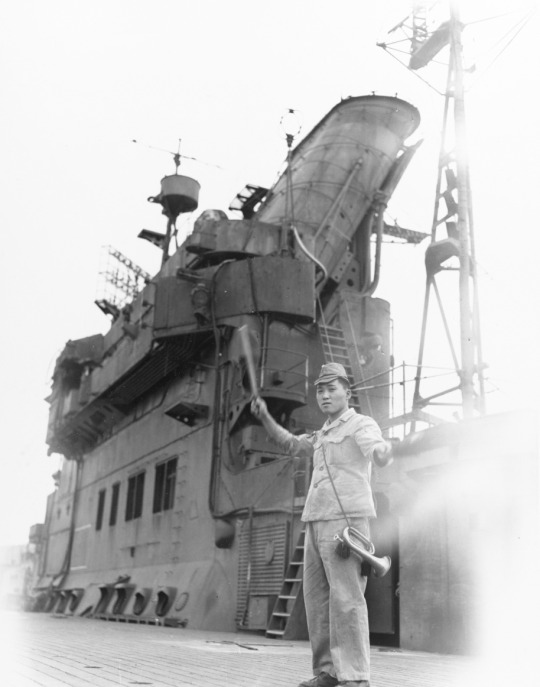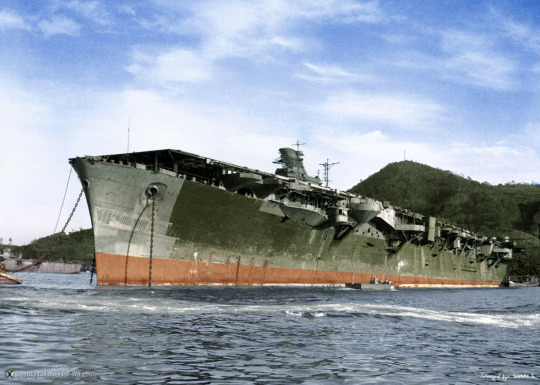#Japanese Aircraft Carrier Jun'yō
Text

A member of the residual crew of Japanese Aircraft Carrier Jun'yō (隼鷹) signals an approaching tug from the carrier's flight deck. Photographed at Sasebo, Japan.
Note this Japanese Signalman's bugle, and details of the ship's island.
Date: October 19, 1945
NHHC: SC 218541
#Japanese Aircraft Carrier Jun'yō#Jun'yō#Hiyō Class#Japanese Aircraft Carrier#Aircraft Carrier#Warship#Ship#Imperial Japanese Navy#IJN#Sasebo#Japan#postwar#post war#October#1945#my post
31 notes
·
View notes
Link
Wikipedia article of the day is Japanese aircraft carrier Jun'yō. Check it out: http://ift.tt/2qZmKSC
1 note
·
View note
Photo

Yoshio Shiga (志賀 淑雄, Shiga Yoshio) was an officer, ace fighter pilot, and leader in the Imperial Japanese Navy (IJN) during the Second Sino-Japanese War and the Pacific theater of World War II. At the December 1941 Attack on Pearl Harbor, Shiga led one of the aircraft carrier Kaga's fighter divisions during the first strike on American forces on Oahu. The number of his Zero fighter was AII-105. Shiga continued as a fighter division commander on Kaga until April 1942.
In May 1942, then Lieutenant Shiga took command of aircraft carrier Jun'yō's fighter group, a post he held until December 1942. During this time, Shiga led the carrier's fighters in the battles of Dutch Harbor and the Santa Cruz Islands. In the latter battle, he attacked the US carriers, USS Hornet (CV-8) and USS Enterprise (CV-6), in which the former was later sunk, while Enterprise was heavily damaged. He subsequently commanded the aircraft carrier Hiyō's fighter group from December 1942 through January 1943 while the carrier was in port in Japan.
After promotion to Lieutenant Commander, Shiga was assigned as air officer to the 343rd Air Group which was engaged in homeland defence in Japan, based at Matsuyama Air Base, in December 1944. He is famous for his strong objection against the tactic of suicide attack (Kamikaze) and saved many lives of Japanese young pilots.
After the war, Shiga became president of police equipment manufacturer Nobel Kōgyō and made many devices such as bulletproof vests and extractable police batons for Japanese police. He died on 25 November 2005.
https://en.wikipedia.org/wiki/Yoshio_Shiga
2 notes
·
View notes
Text
Wikipedia article of the day for June 26, 2017 -- Japanese aircraft carrier Jun'yō
The Wikipedia article of the day for June 26, 2017 is Japanese aircraft carrier Jun'yō.
Jun'yō ("Peregrine Falcon") was a Hiyō-class aircraft carrier of the Imperial Japanese Navy. She was laid down as the passenger liner Kashiwara Maru, but was purchased by the navy in 1941 while still under construction and converted into an aircraft carrier. Launched on 26 June 1941 and completed in May 1942, the ship participated in the Aleutian Islands Campaign the following month and in several battles of the Guadalcanal Campaign later in the year. Her aircraft were used from land bases during several battles in the New Guinea and Solomon Islands Campaigns. Jun'yō was torpedoed in November 1943 and spent three months under repair. She was damaged by several bombs during the Battle of the Philippine Sea in mid-1944, but quickly returned to service. Lacking aircraft, she was used as a transport in late 1944 and was torpedoed again in December. Jun'yō was under repair until March 1945, when work was cancelled as uneconomical. She was then effectively hulked for the rest of the war. After the surrender of Japan in September, the Americans also decided that she was not worth the cost to make her serviceable for use as a repatriation ship, and she was broken up in 1946 and 1947.
0 notes
Photo

Illustration for the First Class Lido Pool areas on the proposed Japanese ocean liners Kashiwara Maru and Izumo Maru, ca. 1941. Planned and ordered by the Japanese NYK (Nippon Yūsen Kaisha) Line, the ships never saw passenger service; still under construction when WWII broke out, they were purchased by the Imperial Japanese Navy and completed as aircraft carriers, the Kashiwara Maru as Jun'yō, and the Izumo Maru as Hiyō, and were both lost during the course of the war.
Artist unknown.
1 note
·
View note
Text
Japanese aircraft carrier Jun'yō
Japanese aircraft carrier Jun’yō
Jun’yō (“Peregrine Falcon”) was a Hiyō-class aircraft carrier of the Imperial Japanese Navy. She was laid down as the passenger liner Kashiwara Maru, but was purchased by the navy in 1941 while still under construction and converted into an aircraft carrier. Launched on 26 June 1941 and completed in May 1942, the ship participated in the Aleutian Islands Campaign the following month and in…
View On WordPress
0 notes
Text


Japanese Aircraft Carrier Jun'yō (隼鷹, Peregrine Falcon) moored at Sasebo, Japan, circa fall 1945.
"The original caption dates the photograph on November 1, 1945, but it may have been taken somewhat earlier."
NHHC: USMC 150350, 80-G-701429
#Japanese Aircraft Carrier Jun'yō#Jun'yō#Hiyō Class#Japanese Aircraft Carrier#Aircraft Carrier#Carrier#Warship#Ship#Imperial Japanese Navy#IJN#Sasebo#Japan#November#1945#Postwar#Post War#my post
22 notes
·
View notes
Text


"View of the island of the Japanese Aircraft Carrier Jun'yō, seen from the aft flight deck, at Sasebo, Japan, on October 19, 1945.
Note the Type 3 radar antenna on the ship's mainmast."
NHHC: SC 218543
Colorized by Steven Walker: link
#Japanese Aircraft Carrier Jun'yō#Jun'yō#Hiyō Class#Japanese Aircraft Carrier#Aircraft Carrier#Warship#Ship#Imperial Japanese Navy#IJN#Sasebo#Japan#October#1945#post war#postwar#colorized#colorized photo#my post
76 notes
·
View notes
Text

"Japanese submarine HA-230 beached at Sasebo, Japan, on October 19, 1945. Three Japanese aircraft carriers and several Kaibokan escort ships are in the background. The carriers are Jun'yō (隼鷹) (center, closest to the camera); Ibuki (伊吹) (partially visible beyond Junyo and Kasagi (partially visible at right). Note the small craft in the foreground, with a registration number painted in its interior."
NHHC: SC 218540
#Japanese submarine HA-230#Ha-201 class#Japanese submarine#Submarine#HA-230#Japanese Aircraft Carrier Jun'yō#Jun'yō#Hiyō Class#Japanese Aircraft Carrier#Aircraft Carrier#Warship#Ship#Imperial Japanese Navy#IJN#Sasebo#Japan#October#1945#postwar#post war#my post
7 notes
·
View notes
Text

"View looking aft from high on the island of the Japanese Aircraft Carrier Jun'yō (隼鷹, "Peregrine Falcon") at Sasebo, Japan. U.S. Army soldiers of the 32nd Division are on the flight deck. Note the fore-and-aft flight deck planking; the device on the landing signal platform; the Type 3 radar antenna on the mainmast and radio-direction-finder loop in the foreground. Several HA-201 class submarines are on the beach in the distance. The submarine directly off Junyō's stern is Ha-230."
Date: October 19, 1945
NHHC: SC 218542
#Japanese Aircraft Carrier Jun'yō#Jun'yō#Hiyō Class#Japanese Aircraft Carrier#Aircraft Carrier#HA-201 class#Japanese Submarine#Submarine#HA-230#Japanese Submarine HA-230#Warship#Ship#Imperial Japanese Navy#IJN#Sasebo#Japan#October#1945#post war#postwar#my post
43 notes
·
View notes
Text






Japanese Aircraft Carrier Jun'yō (隼鷹, "Peregrine Falcon") anchored at Sasebo, Japan.
Date: September 26, 1945.
Note: Two HA-201 class small submarines are alongside in the third photo. Also of note, her flight deck planking is laid fore-and-aft unlike the American carriers with their planking going from port to starboard.
"Jun'yō was attacked by the submarines USS Sea Devil (SS-400), USS Plaice (SS-390) and USS Redfish (SS- 395) early in the morning of December 9, 1944. She was hit by three torpedoes that flooded several compartments and killed 19 men. These gave her a 10°–12° list to starboard, but she was able to proceed on one engine. She reached Sasebo the following day and began repairs on December 18.
The repairs were abandoned in March 1945 for lack of materials and the ship was moved from the dock to Ebisu Bay, Sasebo, on April 1. Efforts to camouflage the ship began on April 23 and she was reclassified as a guard ship on June 20. Jun'yō's armament was ordered removed on August 5 and the ship was surrendered to the Allies on September 2. An American technical team evaluated the ship's condition on October 8 and deemed her a constructive total loss. Jun'yō was stricken from the Navy List on November 30 and scrapped between June 1946 and August 1947 by the Sasebo Ship Company."
NNAM.1996.488.037.002
NHHC: USMC 136995, USMC 136996, USMC 136997, USMC 136998
Colorized by Irootoko Jr: link
Colorized by Steven Walker: link
Excerpt from Wikipedia: link
#Japanese Aircraft Carrier Jun'yō#Jun'yō#Hiyō Class#Japanese Aircraft Carrier#Aircraft Carrier#Warship#Ship#Imperial Japanese Navy#IJN#Sasebo#Japan#HA-201 class#Submarine#Japanese Submarine#postwar#post war#1945#colorized photo#colorized#September#my post
45 notes
·
View notes